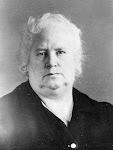COAL MINING IN ENGLAND AS A BACKGROUND TO THE HISTORY OF LOTT RUSSON
Submitted by Carolyn J. Christensen
I read the novel, The Undaunted. The part I enjoyed the most was the description of coal mining in the Black Country of England. The reason – it brought to mind the history of my Great Great Grandfather, Lott Russon. His father was injured and had to quit working in coal mines, and later died when Lott was 13. During the years before his father’s death, Lott worked in the coal mines and was the sole support of his mother and four sisters. As I read The Undaunted, I could picture Lott as a small boy starting the coal mines, and working up through the system until he had married and had eight children at which time he emigrated with his family to America. His story will be posted on this Blog. I have included background information on coal mining. Though lengthy, it will be of interest to some. The history of Lott Russon follows this article.
Following are some information taken from the book, The Undaunted. The author had done much research about coal mining, and though fictional, his characters give knowledge of what it was like to live the life of a collier.
INFORMATION FROM “The Undaunted”
Trappers were children, girls and boys, starting at age 5, who would open and close the tunnel doors in the mines as they heard carts approaching. The door were necessary to help control gasses and air flow in the mines. The Trapper would probably spent much of their time sitting in blackness created hundreds of feet underground. Some tunnels were only high enough to accommodate the carts. Hurriers were children starting at about age nine who would be strapped with chains and harnesses to the front of cart to pull the carts through the low ceiling tunnels, thus, they pulled while crawling on feet and hands. Thrusters were assigned to push the carts from behind to help the hurriers, stooping over to equal the height of the cart. As children got older, there we given difficult positions of harder and more dangerous work. (See pictures below.)
Miners usually worked in their underwear as the air in the mines was extremely warm. Also, they often worked in water knee deep because of seepage.
FOLLOWING: MATERIALS TAKEN FROM INTERNET SITES.
COAL MINING IN ENGLAND
Prior to the Industrial Revolution in the 1700s there was little need for coal and coal miners were few in number. By the 1800s, the coal mining industry was burgeoning. 1
In the 1800s, coal was dug with a pick. Crouching or lying on his side, the collier carefully undercut the seam until a wedge or small powder charge brought the coal crashing down. One usually entered the trade as a boy. Very often a father took his own children, boy or girl as soon as they could open a trap door or push a corve of coal along tracks. In order to survive, a child had to quickly learn how to shore up mine ceilings with timbers and how to recognize the deadly fumes of "black" and "white" damp. Needless to say, mining was one of the most dangerous occupations of this time period. In Yorkshire, more than a thousand people died in mine explosions between 1851 and 1877. Despite the heavy death toll by explosions, it was the less spectacular deaths caused by the less spectacular falls of coal that accounted for most of the deaths in the coal mines.
The miners themselves were responsible for many of the accidents. They took risks like failing to set timbers or build packs. They were often reckless when drawing timber in the goaf, and they sometimes caused explosions by smoking pipes.
Apart from the carelessness of the miner, accidents were also caused by the avarice of the masters and the incompetence of the collier officials. One of the most common forms of neglect was the failure to examine working places before the men entered the mine. Where candles were used for light, men risked an explosion when they entered a gas-filled tunnel.
Ventilation was often inadequate especially in the thin-seamed collieries. Inadequate ventilation meant that the miner was uncomfortable, but also there were accidents under such conditions. Workers became groggy from lack of oxygen, and explosive fumes could accumulate.
For all the danger they faced and their labor, the skilled miner earned between 20 and 30 shillings a week. In addition it was rare for a miner to live past 40 or 50. They often walked home stiffly like cripples bearing the visible signs of over strained muscles. 1
FOR EXAMPLES OF REPORTS TO COMMIDSSIONERS WHEN CHILD LABOR STARTED TO BECOME AN ISSUE IN ENGLAND, SEE THE FOLLOWING LINKS:
http://www.scan.org.uk/education/coal/source1a.html
http://www.historyhome.co.uk/peel/factmine/childmin.htm
http://www.victorianweb.org/history/hist8.html
DESCRIPTIONS OF CONDITIONS IN MINES
“To clear mines of gas - be it explosive or poisonous - a crude system of ventilation was used. To assist this, young children called trappers (sometimes as young as age five) would sit underground (often for hours in complete darkness) opening and shutting trap doors which went across a mine. This allowed coal trucks through but it also created a draught and it could shift a cloud a gas.”
“ A report on deaths in coal mines to Parliament gave a list of ways miners could be killed : falling down a mine shaft on the way down to the coal face falling out of the ‘bucket’ bringing you up after a shift being hit by a fall of dug coal falling down a mine shaft as it was lifted up drowning in the mine crushed to death killed by explosions suffocation by poisonous gas being run over by a tram carrying dug coal in the mine itself.”
“A report informed the public that children under five years of age worked underground as trappers for 12 hours a day and for 2 pennies a day; older girls carried baskets of dug coal which were far too heavy for them and caused deformities in these girls. Often the workers would do twenty journeys a shift pushing a tub which weighed over 200 kilos and if she showed signs of slacking, she would be whipped. Children had to work in water that came up to their thighs while underground”
COAL MINING TERMS
There are hundreds of different terms. These were chosen for this article because they help describe the conditions of the mines and the work done by the miners.
Backskin - A piece of thick leather worn by some putters as a protection to their backs.
Bait - the hasty refreshment taken during the working of the pits. Bat - light stroke, similar to pat.
Caivil - a species of lot drawing or lottery, by which is decided the working-place of each individual.
Cage - the iron framework which contains the tub of coals in its passage and the men in their passage, through the shaft.
Corf - (obviously the Dutch Korf) - a wicker-work basket for drawing the coal and containing from 4 to 7 cwt. It is made of strong hazel-rods from half to one inch in diameter.
Chronic Obstructive Pulmonary Disease - Also known as COPD, an illness caused by obstruction of the flow of air in and out of the lungs, a leading cause of death amongst former miners as there is a recognized link between COPD and coal mine dust.
Davy - the common designation of the Davy-lamp by the miners. (This lamp, after invented in 1815, took the place of candles and was a much safer lighting method.
Gin - a horse-machine for driving coals.
Hewer - the man who extracts the coal. An able-bodied hewer may get about six tons coals a day.
Onsetter - the man who is stationed at the bottom of the shaft to hook and unhook the corves and tub of coals, &c Where tubs are used he has commonly an assistant boy of from 12 to 15 years of age, who is paid from 1s. 3d. to 2s. a-day. (1841)
Overman - the third in rank of the officers of the mine. He has the constant charge of everything underground places the workpeople, examines the ventilation, and keeps an account of all proceedings underground. Two or more are appointed in the most extensive concerns, there being one to each pit. A 'back-overman' is an inferior overman.
Putter - a generic term for the boys who push the trams of coals from the workings to the crane. The term putter comprises the specific distinctions of 'headsman,' 'half marrow,' and 'foal.' The distinction between the labour of the last two is, that a half-marrow goes at each end of the tram alternately with the other half-marrow, while a foal always precedes the tram.
Pick - The tool of the hewer for excavating his coal.
Peck - the coal peck contains 4.5 gallons and 8 pecks make 1 bole,
Rolley - the wagons for transporting the tub or corves of coals from the crane to the shaft. They usually hold each two or three tubs, and are 7 feet 6 inches long at Killingworth.
Rolley-ways - the-principal horse-roads extending into distant parts of the mine and made sufficiently high for an ordinary horse, by cutting away the roof or floor if necessary. Some of these rolley-ways are two miles long they are kept in repair by the rolley-way man.
Sump - the bottom of the shaft connected with the standage.
Standage - a place set apart £or holding accumulations of water in the pit until pumped out by the engine.
Token-hanger - a boy of from 9 to 12 years old, who is paid 1s. or 1s. 2d per day for arranging the tokens attached to each corf to indicate the hewer of its contents.
Tram - a small carriage, in length 3 feet 10 inches, on which the putters, who are thence sometimes called trams, put their coals.
Trapper - a boy or girl who is stationed at a door for guiding the air, to open it when any coal. carriages or people have to pass through it and to close it after them, so as to keep the mine properly ventilated.
Tubs - square vessels of wood or iron for the carriage of the coals. Sometimes all fast and sometimes with a door at the end for the discharge of the coals.
Way-cleaner - a boy or girl who clears the dust, &c. from the rails along which the putters push the trams with two pieces of rope or hay - such boys are usually of from 11 to 15 years of age and earn from ls. 3d. to 2s. 6d. a day. (1841)
Wood and Water Leaders - boys of from 11 to 15 years old, who carry props and wood to the various parts of the pit in which they are required. They also remove water from the horseways and other parts of the pit and assist the deputies. Their wages vary from 1s. 3d. to 2s. a day. (1841)
FOR PICTURES AND DESCRIPTIONS OF COAL MINING SITUATIONS, SEE THE FOLLOWING LINK:
Thursday, January 20, 2011
Subscribe to:
Post Comments (Atom)
.jpg)
.jpg)

No comments:
Post a Comment
Please comment or add information to be published on this site.